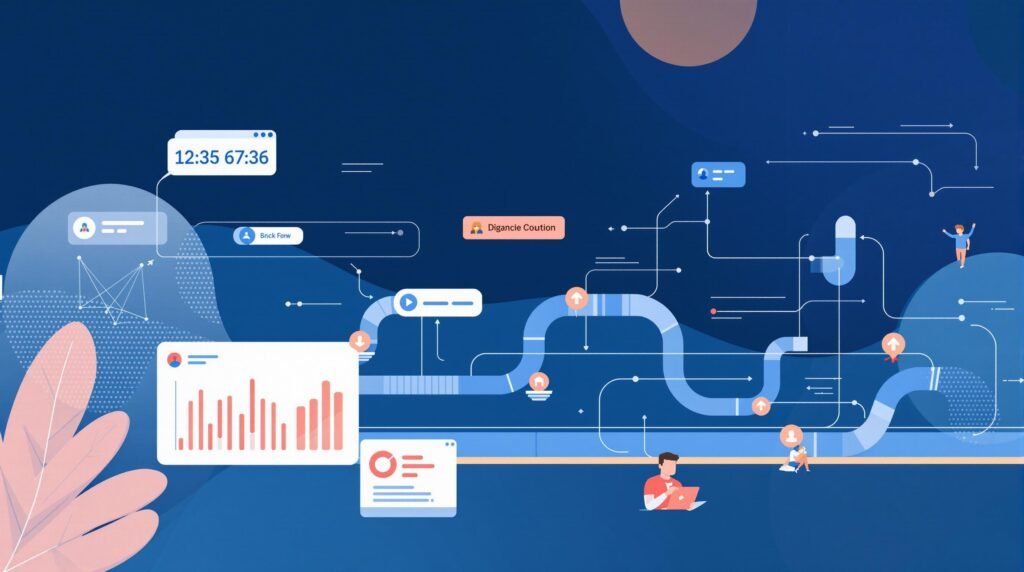Lead tracking helps businesses manage and convert leads efficiently. GoHighLevel simplifies this process with tools like a visual pipeline manager, automated workflows, and detailed analytics. Here’s what you’ll learn:
- Set up pipelines: Create custom sales stages and automate actions.
- Manage leads: Import leads in bulk or add them individually.
- Track progress: Move leads through stages and automate status updates.
- Analyze performance: Use reports to measure lead sources, team activity, and conversion rates.
Quick Summary:
| Feature | Purpose | Key Benefit |
|---|---|---|
| Pipeline Manager | Visualize sales stages | Monitor progress easily |
| Trigger System | Automate lead nurturing | Ensure timely follow-ups |
| Analytics Dashboard | Analyze performance | Identify trends and bottlenecks |
Start with a simple pipeline, use tags and automation to stay organized, and leverage reports to improve your sales process.
Create and Automate Opportunities & Pipelines in GoHighLevel
Creating Sales Pipelines
With GoHighLevel’s lead tracking tools, you can set up a sales pipeline that mirrors your sales process. Here’s how to configure it for smooth lead tracking and conversions.
Finding Pipeline Settings
Start by navigating to the dashboard and selecting Sales Tools > Pipeline Manager. This is your go-to spot for all pipeline configurations and gives you a clear visual of your sales flow.
Here’s a quick rundown of key areas in the interface:
| Menu Item | Location | Purpose |
|---|---|---|
| Pipeline Manager | Sales Tools > Pipeline | Main area for pipeline setup |
| Stage Settings | Pipeline > Settings | Adjust and customize sales stages |
| Automation Rules | Pipeline > Triggers | Create automated workflows and actions |
Setting Up Pipeline Stages
Break your sales process into clear, actionable stages. Common stages might include:
- Qualification
- Discovery Call
- Proposal Sent
- Negotiation
- Closed Won/Lost
For each stage, you can customize:
- Probability percentages: Set the likelihood of leads advancing.
- Default duration: Define how long leads typically stay in each stage.
- Required fields: Ensure all necessary information is captured.
You’ll also want to establish:
- Entry criteria: What qualifies a lead to enter this stage?
- Exit requirements: What needs to happen before moving to the next stage?
- Validation rules: Ensure data accuracy and consistency.
Adding Automation Rules
Take your pipeline to the next level with automation. Here’s what you can do:
- Stage Entry Actions: Set up notifications (email, SMS, or tasks) whenever a lead enters a new stage. This keeps your team informed and ready to act.
- Time-Based Triggers: Automate follow-ups based on how long leads stay in a stage. For instance, send reminders if a lead remains in the “Proposal Sent” stage for more than 5 days.
- Lead Scoring Rules: Use a point system to prioritize leads. Points can adjust automatically based on actions like stage progression or interactions, helping you focus on the most promising opportunities.
Start with the basics, like notifications and reminders, and gradually add more advanced automations as your process evolves.
Up next, learn how to effectively manage leads within your pipeline.
Lead Management Basics
Efficient lead management is all about tracking and converting opportunities effectively.
Bulk Lead Import
To import leads in bulk, upload a CSV file through Contacts > Import.
| Required Fields | Accepted Formats |
|---|---|
| First Name | Text |
| Last Name | Text |
| Valid email address | |
| Phone | E.164 format |
| Custom Fields | As defined |
Here’s how to do it:
- Go to Contacts > Import.
- Upload your CSV file.
- Match your columns to the appropriate GoHighLevel fields.
- Review the data to ensure accuracy.
- Confirm the import process.
Make sure your data is clean and organized in tools like Excel or Google Sheets before uploading. This minimizes errors and ensures a smooth import.
If you’re working with individual entries, check out the next section.
Single Lead Entry
To add a single lead, head to Contacts > Add New and fill in these required details:
- Basic Information: Include the lead’s name, email, and phone number.
- Lead Source: Identify where the lead came from (e.g., referral, ad campaign).
- Pipeline Stage: Place the lead in the appropriate stage of your sales process.
- Deal Value: Estimate the potential revenue from the lead.
- Notes: Add any important context or specific requirements.
Use tags and lead scores to organize and qualify your leads effectively. Once entered, assign the lead promptly to keep your follow-up process on track.
Lead Assignment
Whether you’re importing leads in bulk or adding them individually, proper assignment ensures timely follow-ups and better results.
| Assignment Type | Best Used For | Key Benefits |
|---|---|---|
| Round Robin | High lead volume | Distributes leads evenly across the team |
| Territory-based | Geographic sales | Leverages local knowledge |
| Skill-based | Specialized products or services | Matches leads with the right expertise |
| Manual | High-priority or VIP clients | Offers a personal touch |
To assign a lead, open their profile, choose a team member from the Assignment dropdown, set up notifications, and save the changes.
For automated assignments, use the Rules Engine under Settings > Automation. This lets you create custom routing rules based on factors like lead characteristics or team availability, ensuring leads are directed to the right person quickly.
sbb-itb-1c6633a
Managing Lead Progress
Moving Leads Through Stages
Easily track and manage lead progression with the pipeline view. Navigate to Opportunities > Pipeline View to get started.
To move a lead manually:
- Drag the lead card to the desired stage.
- Update the deal value as needed.
- Add relevant status notes.
For updating multiple leads at once, use the Multi-Select tool in the top-right corner:
- Select the leads you want to update.
- Click Bulk Actions > Update Stage.
- Choose the new stage and confirm the changes.
Pro tip: The “Stage Duration” indicator helps you spot leads that have stalled. If a lead stays in a stage longer than your preset timeframe, it will be flagged automatically for follow-up.
After moving leads, you can further organize them using tags and custom fields.
Lead Tags and Fields
Keep your leads organized with tags and custom fields. GoHighLevel allows you to use system and custom tags to categorize leads. Here are some examples:
| Tag Type | Use Case | Example |
|---|---|---|
| Status Tags | Track engagement level | Hot Lead, Nurturing |
| Source Tags | Identify lead origin | Facebook Ad, Referral |
| Interest Tags | Highlight product interest | Premium Package |
| Follow-up Tags | Plan next steps | Call Today, Email Follow-up |
To add more specific details, create custom fields under Settings > Custom Fields. Common examples include:
- Budget Range
- Decision Timeline
- Company Size
- Industry Vertical
- Preferred Contact Method
Once your leads are tagged and categorized, you can automate status updates to save time.
Automatic Status Updates
Streamline lead management by automating status updates. Use these triggers to keep your pipeline current:
- Email Engagement: Track actions like opening emails, clicking pricing links, downloading resources, or booking appointments.
- Form Submissions: Monitor completed forms, service requests, additional information submissions, or consultation scheduling.
- Activity-Based Triggers: Capture website visits, chat interactions, document views, or payment submissions.
To set up automation rules, go to Settings > Automation > New Rule. Select the trigger events and corresponding status updates to ensure your pipeline stays updated automatically.
Important: Review your automation rules every quarter to ensure they match your current sales process. Adjust thresholds or triggers as needed for optimal performance.
Lead Reports and Analysis
Standard Reports
Head to the Reports tab to explore pre-built lead reports designed to track performance effectively. Here’s what you can expect:
| Report Type | Key Metrics | Update Frequency |
|---|---|---|
| Pipeline Overview | Total leads, Deal values, Conversion rates | Real-time |
| Lead Source Analysis | Source attribution, Cost per lead, ROI | Daily |
| Sales Activity | Contact attempts, Response rates, Close rates | Real-time |
| Team Performance | Individual metrics, Pipeline velocity, Win rates | Weekly |
The dashboard highlights critical metrics like average deal size, lead-to-opportunity ratio, sales cycle duration, and stage conversion rates. These reports provide a clear view of performance and complement the lead tracking tools already covered.
For more tailored insights, consider creating custom reports that align with your specific business needs.
Building Custom Reports
Custom dashboards let you zero in on the metrics that matter most to your business. Here’s how you can build them:
- Select relevant data sources.
- Choose visualization styles.
- Apply date filters.
- Add custom calculations.
- Schedule automated report delivery.
Some useful custom report ideas include:
- Measuring lead scoring success.
- Analyzing campaign attribution models.
- Evaluating sales forecast accuracy.
- Comparing performance across territories.
Once your custom reports are ready, you can easily export the data for additional analysis.
Data Export Options
Exporting lead data is straightforward, with several methods available:
1. Direct CSV Export
Go to Reports > Export and customize your export by selecting:
- Date range.
- Data fields.
- Filter conditions.
- Format (CSV or Excel).
2. API Integration
Leverage the API for automated, real-time exports:
- REST API access.
- Webhook support.
- Batch processing capabilities.
3. Third-party Connections
Seamlessly connect with popular tools like:
Note: When exporting sensitive lead data, always follow your organization’s data protection policies. GoHighLevel logs all export activities for added security and compliance tracking.
Next Steps
Quick Review
GoHighLevel’s lead tracking system offers tools to help you manage your sales pipeline efficiently. Here’s a quick summary:
| Feature | Key Benefits |
|---|---|
| Pipeline Creation | Custom stages and automation |
| Lead Management | Easy imports and assignments |
| Progress Tracking | Stage updates and tagging |
| Reporting Tools | Analytics and insights |
You can start with a 30-day free trial to explore these features. Begin with a single pipeline to keep things simple and expand as your needs grow. For deeper insights, check out the resources listed below.
Additional Help
Need more guidance? These resources can help:
Official Documentation: Find the latest updates and detailed instructions in GoHighLevel’s official documentation.
Extended Support: Thrivepreneurs offers advanced guides covering topics like:
- Configuring complex pipelines
- Setting up custom automation rules
- Strategies for integrations
- Tips for effective lead management
Pro Tip: Begin with a straightforward pipeline setup. As you get familiar with how leads progress through your sales process, you can gradually introduce more advanced features. This way, your team won’t feel overwhelmed, and you’ll maintain accurate lead tracking from the start.


